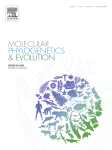Ver ítem
- xmlui.general.dspace_homeCentros Regionales y EEAsCentro Regional Patagonia NorteEEA BarilocheArtículos científicosxmlui.ArtifactBrowser.ItemViewer.trail
- Inicio
- Centros Regionales y EEAs
- Centro Regional Patagonia Norte
- EEA Bariloche
- Artículos científicos
- Ver ítem
High genetic variation in marginal fragmented populations at extreme climatic conditions of the Patagonian Cypress Austrocedrus chilensis
Resumen
Knowledge about current patterns of genetic structure of populations together with the evolutionary history of a species helps to understand and predict the adaptation of populations to future climate change. We assayed variation at nuclear microsatellite markers among peripheral vs. continuous populations of the temperate South American species Austrocedrus chilensis, to investigate the role of historical vs. demographical forces in shaping population
[ver mas...]
Knowledge about current patterns of genetic structure of populations together with the evolutionary history of a species helps to understand and predict the adaptation of populations to future climate change. We assayed variation at nuclear microsatellite markers among peripheral vs. continuous populations of the temperate South American species Austrocedrus chilensis, to investigate the role of historical vs. demographical forces in shaping population genetic structure. This species occurs in continuous populations in
the west and central distribution range, but becomes highly fragmented at the eastern limit, which comprised ice-free areas during Quaternary glaciations and has extreme climatic conditions at present times. Bayesian analysis methods identified two contrasting patterns of genetic structure; (I) populations from humid, mesic and peri-glacial regions formed a single deme with relatively low genetic differentiation and high admixture levels whereas (II) a highly heterogeneous genetic structure with low level of admixture
was found in the steppe, towards the east and northeast limit of the distribution range. In the steppe, population fragmentation, restricted gene flow and isolation-by-distance were also inferred. In addition, several small steppe populations showed high genetic diversity and divergent gene pools, suggesting that they constitute ancient refuges from pre-Holocene glaciations with just a subgroup of them contributing significantly to post-glacial spread. These results are discussed in relation to patterns of genetic variation
found for other temperate species and the contribution of the particular southern Andes topography and climate to post-glacial spread.
[Cerrar]

Autor
Arana, María Veronica;
Gallo, Leonardo Ariel;
Vendramin, Giovanni Giuseppe;
Pastorino, Mario Juan;
Sebastiani, Federico;
Marchelli, Paula;
Fuente
Molecular Phylogenetics and Evolution 54 (3) : 941-949 (Marzo 2010)
Fecha
2010-03
Editorial
Elsevier
ISSN
1055-7903
Formato
pdf
Tipo de documento
artículo
Palabras Claves
Derechos de acceso
Restringido
 Excepto donde se diga explicitamente, este item se publica bajo la siguiente descripción: Creative Commons Attribution-NonCommercial-ShareAlike 2.5 Unported (CC BY-NC-SA 2.5)
Excepto donde se diga explicitamente, este item se publica bajo la siguiente descripción: Creative Commons Attribution-NonCommercial-ShareAlike 2.5 Unported (CC BY-NC-SA 2.5)

